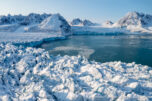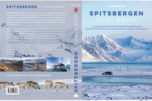-
current
recommendations- Liefdefjord
New page dedicated to one of Spitsbergen's most beautiful fjords. Background information and many photos.
- New Spitsbergen guidebook
The new edition of my Spitsbergen guidebook is out and available now!
- Liefdefjord
New page dedicated to one of Spitsbergen's most beautiful fjords. Background information and many photos.
Page Structure
-
Spitsbergen-News
- Select Month
- May 2025
- April 2025
- March 2025
- February 2025
- January 2025
- December 2024
- November 2024
- October 2024
- September 2024
- August 2024
- July 2024
- June 2024
- May 2024
- April 2024
- March 2024
- February 2024
- January 2024
- December 2023
- November 2023
- October 2023
- September 2023
- August 2023
- July 2023
- June 2023
- May 2023
- April 2023
- March 2023
- February 2023
- January 2023
- December 2022
- November 2022
- October 2022
- September 2022
- August 2022
- July 2022
- June 2022
- May 2022
- April 2022
- March 2022
- February 2022
- January 2022
- December 2021
- November 2021
- October 2021
- September 2021
- August 2021
- July 2021
- June 2021
- May 2021
- April 2021
- March 2021
- February 2021
- January 2021
- December 2020
- November 2020
- October 2020
- September 2020
- August 2020
- July 2020
- June 2020
- May 2020
- April 2020
- March 2020
- February 2020
- January 2020
- December 2019
- November 2019
- October 2019
- September 2019
- August 2019
- July 2019
- June 2019
- May 2019
- April 2019
- March 2019
- February 2019
- January 2019
- December 2018
- November 2018
- October 2018
- September 2018
- August 2018
- July 2018
- June 2018
- May 2018
- April 2018
- March 2018
- February 2018
- January 2018
- December 2017
- November 2017
- October 2017
- September 2017
- August 2017
- July 2017
- June 2017
- May 2017
- April 2017
- March 2017
- February 2017
- January 2017
- December 2016
- November 2016
- October 2016
- September 2016
- August 2016
- July 2016
- June 2016
- May 2016
- April 2016
- March 2016
- February 2016
- January 2016
- December 2015
- November 2015
- October 2015
- September 2015
- August 2015
- July 2015
- June 2015
- May 2015
- April 2015
- March 2015
- February 2015
- January 2015
- December 2014
- November 2014
- October 2014
- September 2014
- August 2014
- July 2014
- June 2014
- May 2014
- April 2014
- March 2014
- February 2014
- January 2014
- December 2013
- November 2013
- October 2013
- September 2013
- August 2013
- July 2013
- June 2013
- May 2013
- April 2013
- March 2013
- February 2013
- January 2013
- December 2012
- November 2012
- October 2012
- September 2012
- August 2012
- July 2012
- June 2012
- May 2012
- April 2012
- March 2012
- February 2012
- January 2012
- December 2011
- November 2011
- October 2011
- September 2011
- August 2011
- May 2011
- April 2011
- March 2011
- February 2011
- January 2011
- December 2010
- November 2010
- September 2010
- August 2010
- July 2010
- June 2010
- May 2010
- April 2010
- March 2010
- February 2010
- November 2009
- October 2009
- August 2009
- July 2009
- June 2009
- May 2009
- April 2009
- March 2009
- February 2009
- January 2009
- December 2008
- November 2008
- October 2008
- August 2008
- July 2008
- June 2008
- May 2008
- April 2008
- March 2008
- February 2008
- April 2000
- Select Month
-
weather information
-
Newsletter

| Guidebook: Spitsbergen-Svalbard |
Home → September, 2018
Monthly Archives: September 2018 − News
The Svalbard Global Seed Vault: online-tour in 360 degree panorama format
Most people will never have the chance to visit the famous Svalbard Global Seed Vault beyond a glimpse of the entrance from outside. Colloquially also known as “doomsday vault”, it is used since 2008 to store seeds of food crops to make sure the species survive even when all other stocks are destroyed by natural or man-made ecological disasters or war.
The inside of the Svalbard Global Seed Vault is, however, closed to the public. Only those who are working there, some VIP visitors and media teams, on certain dates and with prior registration, get inside. During a media visit in 2016, I had the rare chance to photograph the Seed Vault including 360 degree panoramas, which can now be seen on this page (click here). Parts of the Seed Vault are currently under renovation.
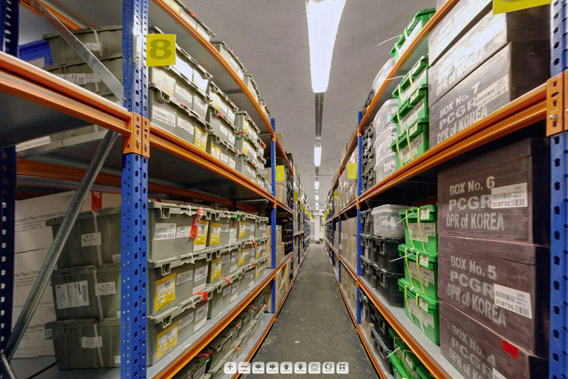
The Svalbard Global Seed Vault is now accessible as a panorama tour on this website.
Polar bear family in Bjørndalen near Longyearbyen
Today (Monday, 10 September), a polar bear family was seen near Vestpynten, not far from the airport and campsite at Longyearbyen. It was a female bear with two first-year cubs, probably the same polar bears that were seen on Saturday at Revneset, on the north side of Adventfjord opposite of Longyearbyen. On Saturday, the bears were chased away by helicopter towards Sassenfjord, away rom Longyearbyen.
Polar bears including females with cubs regularly cover large distances. A walk including longer swimming distances from Adventfjord (Longyearbyen) to Sassenfjord and back within 2 days is fully realistic and normal.
When the bears were seen near Vestpynten today around 16.00, both curious onlookers and the Sysselmannen (police) were soon on the scene, as reported by Svalbardposten. The Sysselmannen followed the polar bear family by car slowly towards Bjørndalen further west.
There, hopes that the bears might continue and disappear from the Longyearbyen area soon vanished in the haze, as the bears were seen feeding on a large whale carcass, possibly from a sperm whale as appears on a photo taken by the Sysselmannen. This might provide the bears in question with food for a longer period, if the whale does not start to float and drift away again. Chances are also that the whale carcass attracts further bears.
The Sysselmannen asks the public not to get close to the bears and to be alert and to exercise usual safety measures at any time in the field.
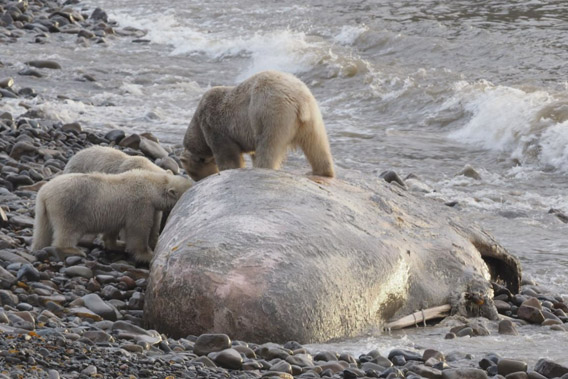
Polar bear family with a solid meal in Bjørndalen near Longyearbyen, Monday (10 September) afternoon. Photo © Sysselmannen.
Update: the polar bears were scared away from the whale carcass by the Sysselmannen later on Monday, as Svalbardposten wrote. The dead whale was towed into the fjord by Polarsyssel, the Sysselmannen’s ship, and the bears were scared and moved up into Bjørndalen.
The Spitsbergen-Calendar 2019 is available
Our already almost traditional Spitsbergen-calender ist now available for 2019. It is available as before in the bigger A3 format (beautiful on the wall) and the smaller A5 (great for example on the table or on the wall where not so much space is available).

With arctic impressions through the year: the new calendar Spitsbergen 2019 is now available.
As opposed to other offers available on the market, we select a set of 12 entirely new photos every year to create a completely new calendar with fresh impressions, showing some of Spitsbergen’s most beautiful sides including scenery, wildlife and flowers.
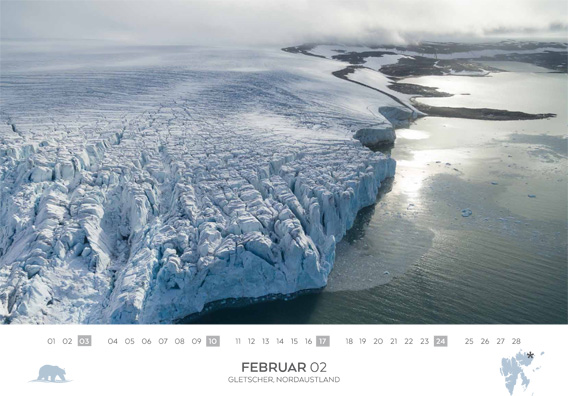
Unusual perspective of an impressive landscape: the ice cap Austfonna seen from the air.
Unusual perspectives of remote places together with stunning wildlife photos form a good part of the selection, which is completed by flowers and stunning scenery of polar landscapes and ice.

Of course there are some polar bears in the calendar 🙂
Click here to see all images of the Spitsbergn calender 2019, more information and ordering.
Job market in Longyearbyen growing in spite of reduction in coal mining
The great fear of a collapse of the job market in Longyearbyen after the significant reduction of coal mining, especially in Sveagruva, did not become reality so far. This is indicated by the latest statistics of the Statistik Sentralbyrå, the Norwegian directory of statistics. In 2017, there were 4.2 % more jobs in Svalbard compared to 2016. The number of jobs in mining were actually reduced by 34 % down to 100, but this loss was more than compensated by growth in other branches, mostly in relation to tourism. Hotels and restaurants created 36.3 % more jobs in 2017 than in 2016, totalling 315 jobs in 2015. ´
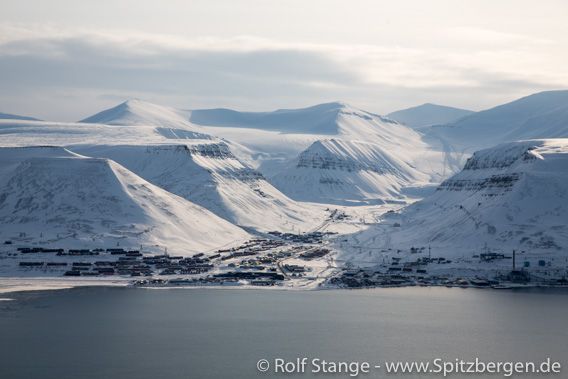
Longyearbyen is growing, also on the job market: 4,2 % more jobs in 2017.
This growth is measured in “Årsverk”, which may be best translated with “man hours per year”. 315 “årsverk” do not necessarily mean 315 full-time employees, but an amount of paid work that could be done by 315 people within one year. This amount of work may, however, be spread over a larger number of part-time or seasonal jobs, which is certainly the case to some degree in tourism. “Tourism” as such is not a category in the statistics. Jobs created within tourism are measured in categories such as hotels & restaurants, service industry and transport and logistics.
News-Listing live generated at 2025/May/04 at 03:24:56 Uhr (GMT+1)
